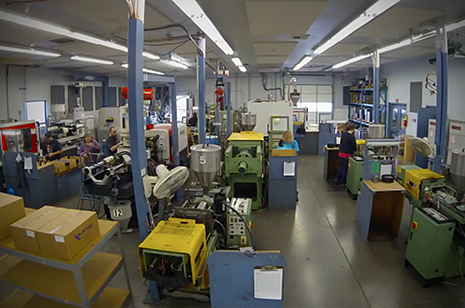- BY nwmcadmin
- POSTED IN Plastic Injection Molding
- WITH 0 COMMENTS
- PERMALINK
- STANDARD POST TYPE

The aerospace industry hinges on precision, durability, and weight efficiency. Every component—from cabin panels to avionics housings—must endure extreme conditions while remaining as light as possible.
Injection molding has become an essential part of aerospace product development. By enabling the production of durable, lightweight components with tight tolerances, it supports both performance and regulatory compliance. Understanding its role requires a look at how aerospace parts are designed and manufactured.
How Aerospace Parts Are Designed and Manufactured
Aerospace design begins with performance requirements. Engineers must account for aerodynamics, weight reduction, fuel efficiency, and safety regulations. Each part—whether a cabin component or structural support—is carefully designed to handle extreme conditions like pressure changes, high temperatures, and vibration.
After design, manufacturers select the production method that balances cost, material performance, and regulatory compliance. Machined parts to aerospace standards are often required for critical systems, while processes like 3D printing or aerospace plastic molding provide flexibility for complex shapes or lightweight applications.
Key Manufacturing Methods in Aerospace
Aircraft manufacturers rely on several production methods, each chosen for precision, performance, and efficiency. No single process meets every need; engineers weigh cost, materials, and the part’s role before deciding on the best approach.
Machining
Machining remains a cornerstone of aerospace manufacturing. CNC milling, turning, and drilling can shape metals and composites into parts with the tightest tolerances. This method is ideal for structural components, engine assemblies, and other critical systems where reliability is paramount.
3D Printing
Additive manufacturing, or 3D printing, introduces new freedom in aerospace design. It allows engineers to create intricate geometries, like lattice structures, that would be impossible to machine. Because tooling isn’t required, 3D printing is particularly effective for prototypes, low-volume runs, or customized parts needing quick turnaround.
Injection Molding
Injection molding excels in producing large numbers of consistent, lightweight plastic parts (you can read more about this process in our detailed writeup here). It is well-suited for interior components such as overhead bins, paneling, and housings. Beyond reducing weight, injection molding lowers manufacturing costs while still meeting strict aerospace standards.
Aerospace Injection Molding
While machining and 3D printing remain vital, injection molding offers unique advantages for aerospace product development. It allows engineers to produce parts that are both lightweight and highly durable. Once a mold is built, manufacturers can quickly produce large quantities of identical components, saving time and cost.
Precision is another benefit. Aerospace plastic molding achieves tight tolerances and consistent quality across thousands of parts. For applications where uniformity is critical—like cabin interiors or electronic housings—this repeatability ensures every component performs as expected.
Applications for Injection Molding in the Aerospace Industry
Injection molding is widely used for interior components like:
- Overhead panels
- Tray tables
- Seat components
- Ventilation ducts
Non-structural housings for avionics and other systems also benefit from injection molding’s ability to create precise, repeatable parts efficiently. Because the process produces uniform components at scale, manufacturers can meet strict aerospace safety and compliance requirements without compromising performance.
Considerations for Aerospace Injection Molding
When designing injection-molded components, engineers must balance performance, weight, and compliance. Even small design decisions can impact safety, efficiency, and manufacturability.
Lightweighting
Weight reduction is a top priority in aircraft design. Every gram saved improves fuel efficiency and overall performance. Injection molding allows for complex geometries, thin walls, and integrated features that reduce material use without sacrificing strength. Techniques like ribbing, hollow structures, and lattice designs help achieve optimal strength-to-weight ratios.
Aerospace standards and compliance
Aerospace plastic molding must meet rigorous standards. Components are evaluated for flame retardancy, smoke generation, toxicity, and durability under extreme conditions. Compliance with AS9100 and FAA requirements ensures that molded parts are safe for both passengers and critical systems. Material certification and process validation are essential to meet these standards consistently.
Material Selection and Performance
Choosing the right material is crucial. Engineers typically consider:
- PEEK (Polyether Ether Ketone): Exceptional heat resistance, chemical stability, and mechanical strength. Often used for avionics housings and high-performance structural components.
- Ultem (PEI): Lightweight, flame-retardant, and strong, ideal for cabin interiors and electrical connectors.
- Polycarbonate-ABS blends: Durable, impact-resistant, and cost-effective, suitable for non-structural interior components.
When selecting materials, engineers evaluate mechanical properties, thermal performance, chemical exposure, and manufacturability. Proper material choice ensures components can withstand operational demands, meet aerospace compliance standards, and remain efficient to produce.
Have questions? Get expert guidance.
Aerospace injection molding plays a crucial role in producing lightweight, durable, and compliant aircraft components. Every project is unique, and design or manufacturing decisions can impact performance, cost, and compliance.
Working with experts early in the development process can save time, reduce risk, and result in higher-quality parts.
Rex Plastics offers guidance and support for aerospace injection molding projects. Contact us to connect with their team and get advice tailored to your project needs.
Referencing content from this page? Please attribute Rex Plastics with either of these links:
https://rexplastics.com/ or https://rexplastics.com/plastic-injection-molding/aerospace-injection-molding/
Suggested APA citation:
Rex Plastics Blog. (2025, September 27). The Unique World of Aerospace Injection Molding. Rex Plastics. https://rexplastics.com/plastic-injection-molding/aerospace-injection-molding/


